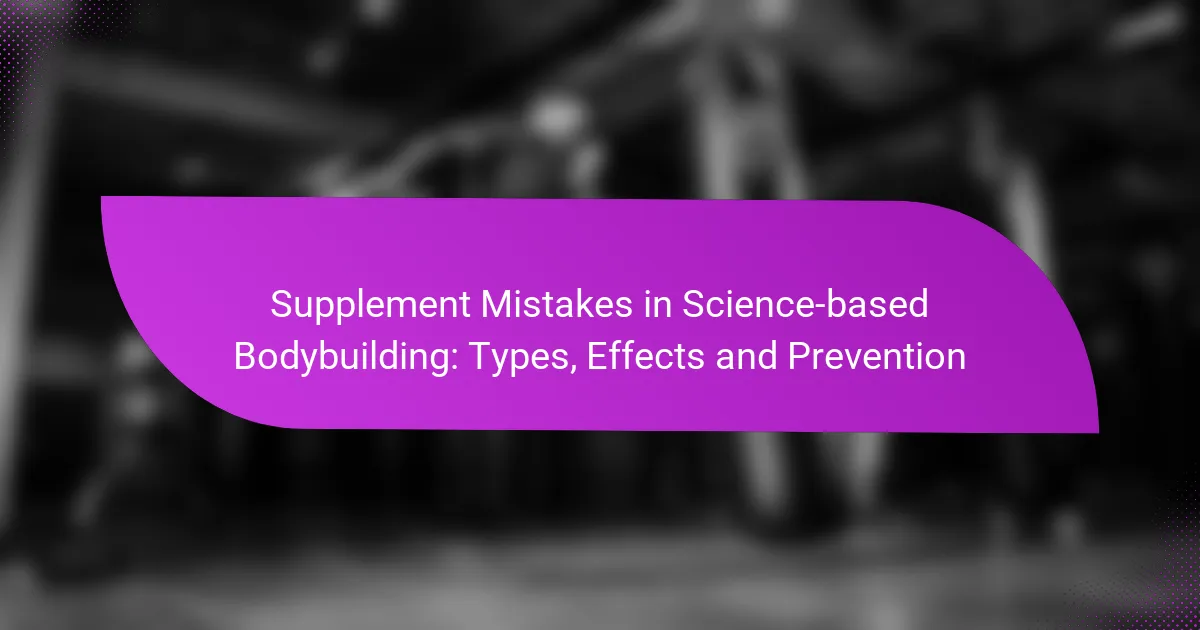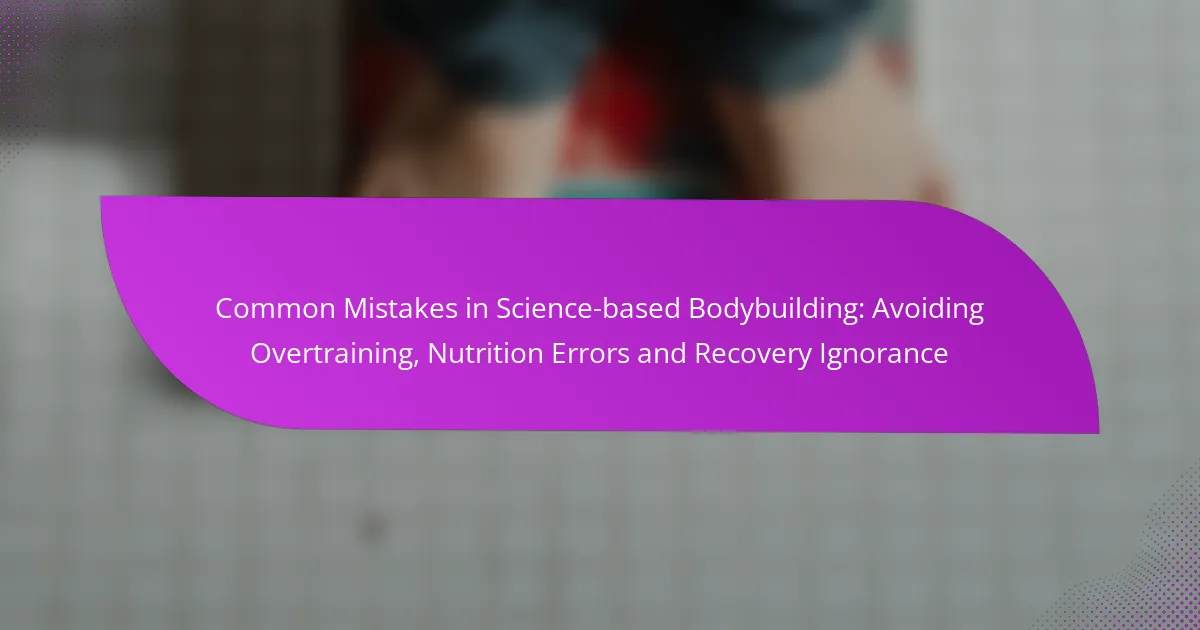Recovery ignorance in science-based bodybuilding can significantly hinder progress, leading to injuries, stunted muscle growth, and negative impacts on mental health. To achieve optimal performance and longevity in the sport, it is essential to understand the importance of recovery and implement effective strategies, such as structured rest, proper nutrition, and quality sleep.

What Are the Consequences of Recovery Ignorance in Bodybuilding?
Recovery ignorance in bodybuilding can lead to various negative outcomes, including increased injury risk, decreased muscle growth, and impaired mental health. Understanding these consequences is crucial for optimizing performance and ensuring long-term success in bodybuilding.
Increased injury risk
Neglecting recovery can significantly heighten the risk of injuries, such as strains, sprains, and overuse injuries. When muscles and joints are not given adequate time to heal, they become more susceptible to damage during workouts.
To mitigate this risk, incorporate rest days into your training schedule and listen to your body’s signals. If you experience persistent pain or fatigue, it may be a sign that you need to adjust your workout intensity or frequency.
Decreased muscle growth
Recovery is essential for muscle repair and growth. Without sufficient recovery time, the body struggles to rebuild muscle fibers, leading to stagnation or even loss of muscle mass.
Aim for at least 48 hours of recovery for each muscle group after intense training. This allows for optimal protein synthesis and muscle adaptation, which are critical for achieving your bodybuilding goals.
Negative impact on mental health
Ignoring recovery can also adversely affect mental health, leading to increased stress, anxiety, and burnout. The physical strain of overtraining can contribute to a negative mindset and decreased motivation.
To promote mental well-being, prioritize rest and recovery strategies such as mindfulness, adequate sleep, and engaging in leisure activities outside of bodybuilding. These practices can help maintain a positive outlook and enhance overall performance.
Longer recovery times
Failure to prioritize recovery can result in longer recovery times after workouts. This can disrupt training schedules and hinder progress, making it difficult to achieve fitness goals.
Implementing active recovery techniques, such as light cardio or stretching, can help facilitate quicker recovery. Additionally, consider using foam rollers or massage therapy to alleviate muscle soreness and improve circulation.
Impaired performance
Inadequate recovery directly impacts performance levels, leading to decreased strength, endurance, and overall athletic ability. Over time, this can result in a plateau or decline in performance metrics.
To maintain peak performance, ensure you are getting enough sleep, proper nutrition, and hydration. Incorporating recovery protocols into your routine can help you stay at your best and avoid performance dips.

What Strategies Can Improve Recovery in Bodybuilding?
Improving recovery in bodybuilding involves implementing effective strategies that enhance muscle repair and overall performance. Key approaches include structured rest days, active recovery techniques, proper nutrition, quality sleep, and the use of recovery technologies.
Implementing structured rest days
Structured rest days are essential for allowing muscles to recover and grow stronger. Schedule at least one to two rest days per week, depending on your training intensity and volume. During these days, avoid strenuous activities to give your body time to repair itself.
Consider a split routine where you alternate muscle groups, allowing specific areas to rest while others are trained. This approach can help maintain workout frequency while ensuring adequate recovery for each muscle group.
Utilizing active recovery techniques
Active recovery techniques involve low-intensity exercises that promote blood flow without straining the muscles. Activities such as walking, cycling, or light swimming can help reduce muscle soreness and stiffness after intense workouts.
Incorporate active recovery sessions into your routine, especially after heavy lifting days. Aim for 20-30 minutes of light activity to facilitate recovery while keeping your body engaged.
Incorporating proper nutrition
Proper nutrition plays a crucial role in recovery by providing the necessary nutrients for muscle repair. Focus on a balanced diet rich in protein, healthy fats, and carbohydrates to support your recovery efforts.
Post-workout meals should ideally include protein and carbohydrates within 30-60 minutes after training. Aim for a protein intake of around 20-30 grams to optimize muscle recovery and growth.
Prioritizing sleep quality
Quality sleep is vital for recovery, as it is during sleep that the body repairs tissues and builds muscle. Aim for 7-9 hours of uninterrupted sleep each night to maximize recovery benefits.
Create a sleep-friendly environment by minimizing light and noise, and establish a consistent sleep schedule. Avoid caffeine and electronic devices before bedtime to improve sleep quality.
Using recovery technologies
Recovery technologies, such as foam rollers, compression garments, and electrical stimulation devices, can enhance recovery by reducing muscle soreness and improving circulation. Incorporate these tools into your routine to speed up recovery times.
Consider using foam rollers after workouts to alleviate tightness and improve flexibility. Compression garments can be worn during and after workouts to enhance blood flow and reduce swelling.

How Does Nutrition Affect Recovery in Bodybuilding?
Nutrition plays a crucial role in recovery for bodybuilders by providing the necessary nutrients to repair muscles and replenish energy stores. Proper nutrition can significantly enhance recovery times and overall performance, making it essential to focus on specific macronutrients and hydration strategies.
Importance of protein intake
Protein intake is vital for muscle recovery as it provides the amino acids needed for muscle repair and growth. Aim for a daily intake of about 1.6 to 2.2 grams of protein per kilogram of body weight, depending on your training intensity and goals.
Post-workout, consuming protein within 30 to 60 minutes can maximize muscle protein synthesis. Good sources include lean meats, dairy, eggs, and plant-based options like legumes and tofu.
Role of carbohydrates in recovery
Carbohydrates are essential for replenishing glycogen stores depleted during workouts. Consuming carbohydrates after exercise can help restore energy levels and improve recovery. A general guideline is to consume 1 to 1.5 grams of carbohydrates per kilogram of body weight within the first two hours post-exercise.
Incorporate complex carbohydrates such as whole grains, fruits, and vegetables into your meals to ensure sustained energy release. Simple sugars can also be beneficial immediately after workouts for quick recovery.
Hydration’s impact on recovery
Hydration is critical for optimal recovery as it affects muscle function and nutrient transport. Dehydration can lead to decreased performance and longer recovery times. Aim to drink at least 2 to 3 liters of water daily, adjusting based on your activity level and sweat loss.
Electrolyte balance is also important; consider incorporating sports drinks or electrolyte supplements during intense training sessions to maintain hydration and support recovery.
Supplements for enhanced recovery
While whole foods should be the foundation of your nutrition, certain supplements can aid recovery. Branched-chain amino acids (BCAAs), creatine, and omega-3 fatty acids are popular options that may help reduce muscle soreness and inflammation.
Consult with a healthcare professional before starting any supplement regimen to ensure they align with your specific needs and goals. Always prioritize a balanced diet first, using supplements as an adjunct to your nutrition plan.

What Recovery Technologies Are Available for Bodybuilders?
Bodybuilders have access to various recovery technologies designed to enhance muscle recovery and reduce soreness. These technologies include foam rollers, compression therapy devices, cold therapy systems, and electrical stimulation units, each offering unique benefits and considerations.
Foam rollers
Foam rollers are simple yet effective tools for self-myofascial release, helping to alleviate muscle tightness and improve flexibility. By applying pressure to specific muscle groups, they can enhance blood flow and promote recovery after intense workouts.
When using a foam roller, focus on areas that feel particularly tight or sore. Roll slowly over these spots for about 30 seconds to a minute, adjusting pressure as needed. Incorporating foam rolling into your routine 2-3 times per week can yield significant benefits.
Compression therapy devices
Compression therapy devices use controlled pressure to improve circulation and reduce muscle soreness. These devices often come in the form of sleeves or boots that apply pressure to the limbs, helping to flush out metabolic waste and reduce swelling.
For optimal results, use compression therapy for 30-60 minutes post-workout. Many athletes find that using these devices 2-3 times a week can enhance recovery and reduce the risk of injury.
Cold therapy systems
Cold therapy systems, such as ice baths or cryotherapy chambers, are designed to reduce inflammation and numb pain after intense training sessions. The cold constricts blood vessels, which can help minimize swelling and muscle soreness.
Consider using cold therapy within 24 hours after a strenuous workout for the best results. Sessions typically last between 10-20 minutes, and athletes often alternate between cold and warm therapies to maximize recovery benefits.
Electrical stimulation units
Electrical stimulation units deliver low-level electrical impulses to muscles, promoting relaxation and recovery. These devices can help reduce muscle spasms and enhance blood flow, making them a valuable addition to a recovery regimen.
When using electrical stimulation, follow the manufacturer’s guidelines for duration and intensity. Sessions can last from 20-40 minutes, and using these units 2-3 times a week can support muscle recovery and overall performance.



